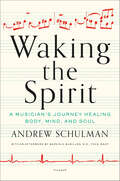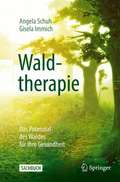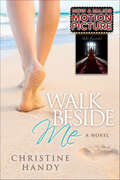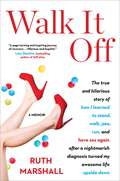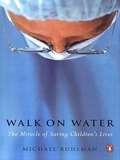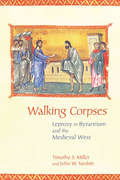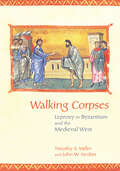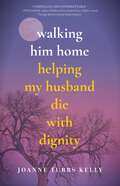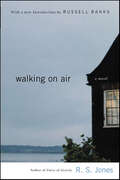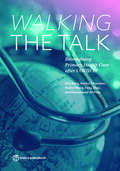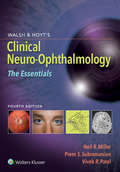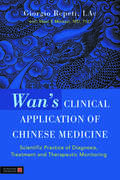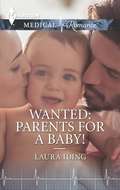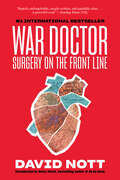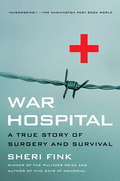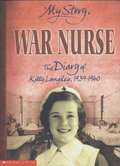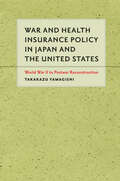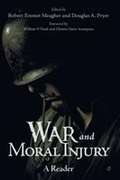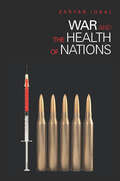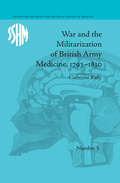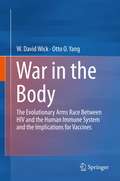- Table View
- List View
Waking the Spirit: A Musician's Journey Healing Body, Mind, and Soul
by Andrew SchulmanAn Oliver Sacks Foundation Best Book of the Year Selection, Finalist for the Books for a Better Life "Best First Book” Award, and a People Magazine Pick in nonfiction.The astounding story of a critically ill musician who is saved by music and returns to the same hospital to help heal othersAndrew Schulman, a fifty-seven-year-old professional guitarist, had a close brush with death on the night of July 16, 2009. Against the odds—and with the help of music—he survived: a medical miracle.Once fully recovered, Andrew resolved to use his musical gifts to help critically ill patients at Mount Sinai Beth Israel’s ICU. In Waking the Spirit, you’ll learn the astonishing stories of the people he’s met along the way—both patients and doctors—and see the incredible role music can play in a modern hospital setting.Schulman expertly weaves cutting-edge research on neuroscience and medicine, as well as what he’s learned as a professional musician, to explore the power of music to heal the body and awaken the spirit.
Waldenström’s Macroglobulinemia
by Véronique Leblond Steve Treon Meletios DimoploulosThis book sheds new light on clinical, biological and therapeutic data on the rare disease Waldenstr#65533;m's Macroglobulinemia (WM) with the participation of widely-recognized experts, involved in this field. It represents the efforts of physicians, scientists and patients, all around the world, to better understand and cure this rare disease. Considerable advances in the diagnosis, treatment indications, response criteria, prognostic factors and treatment options have been made since Dr Jan Waldenstr#65533;m first reported this "new syndrome" 70 years ago. Particularly instrumental in advancing of our understanding of WM have been the eight international workshops devoted to this disease. New, exciting molecular data have recently been reported, allowing us to revisit the oncogenic events leading to WM B-cell proliferation and to use newly available compounds targeting oncogenic pathways.
Waldtherapie - das Potential des Waldes für Ihre Gesundheit
by Angela Schuh Gisela ImmichIm schnelllebigen Alltag wird es immer wichtiger, einen Gegenpol zu finden. Der Wald scheint dafür wie geschaffen – er bietet ausgleichende Reize, gesundheitsfördernde Effekte und sein Klima ist nachgewiesen wirksam. Das Sachbuch erklärt auf wissenschaftlich fundierter Basis die Hintergründe und Fakten zur Wirkung von Waldaufenthalten und sensibilisiert Leserinnen und Leser für den großen Gesundheitsnutzen von Waldbaden (Shinrin-yoku) und Waldtherapie. Der Wald lädt als Ruheoase ein zu entschleunigen, zu regenerieren und neue Energie zu schöpfen. Geschrieben für interessierte Laien – Psychotherapeuten, Ärzte und andere Gesundheitsberufe können mitlesen. Aus dem Inhalt: Wie der Wald und sein Klima auf uns wirkt – Wie Sie den Wald und seine Atmosphäre für Ihre Gesundheit entdecken und nutzen können. Die Autorinnen: Prof. Dr. Dr. Angela Schuh und Gisela Immich, M.Sc., beforschen an der Ludwig-Maximilians-Universität München die Wirkungen von Wald und Klima auf die Gesundheit und entwickeln Konzepte für die präventive Waldnutzung und Waldtherapie.
Walk Beside Me: A Novel
by Christine HandyAfter relentless suffering, a woman decides to end her life—until a few real-life angels start showing up . . . A model-turned-wife-and-mother, Willow Adair lives with her husband and kids in Bexley, one of the wealthiest neighborhoods in Columbus, Ohio. On the outside, she has everything. On the inside, she struggles with her self worth. Spurned by her neglectful husband and defied by her rebellious teen daughter, Willow never feels she&’s good enough, and fears everyone she loves will leave. Piece by piece, the cornerstones of Willow&’s life begin to crumble. A routine operation goes horribly wrong, requiring a long recovery. A yoga injury leads to pain, surgeries, and misdiagnoses, ending in a permanent loss of motion in her arm. Then, as if she hasn&’t suffered enough, Willow is diagnosed with breast cancer. Convinced no one will stand by her for one more day of sickness and depression, she prepares to end her life. But Willow&’s friends go with her to chemo. They sleep over at her house. They lift her spirits when she&’s sad, and weep with her when she&’s hurting. They walk beside her literally, on sidewalks from Cleveland to Miami. And they walk beside her spiritually and emotionally, soothing her heartache, healing her self-esteem, and reminding her that every single minute of her life is abundantly worth living. Walk Beside Me is a tale of sickness and triumph, of being comfortable in your own skin, of valuing the things that have true value, and of learning to fight for yourself and what you truly want. It&’s the story of a woman who peels away the layers to find her inner warrior, a woman who faces insurmountable odds and—thanks to her earthly Angels—learns to treasure the gift of God&’s infinite light and love.
Walk It Off: The True and Hilarious Story of How I Learned to Stand, Walk, Pee, Run, and Have Sex Again After a Nightmarish Diagnosis Turned My Awesome Life Upside Down
by Ruth MarshallFuriously Happy meets Elaine Lui in this truly original—and surprisingly hilarious—memoir about one woman’s journey to learn how to walk after a debilitating diagnosis turned her life upside down.Learn How to Walk (Again) To-Do List: Step 1: Stand Step 2: Step Step 3: Pee (Yes!) Step 4: Walk with walker Step 5: Walk with sticks Step 6: Walk without props Recreational interlude for sex Step 7: RUN! Ruth Marshall—power mom, wife, actor, and daughter—was in great health, until one day, her feet started to tingle. She visited doctors and specialists for tests, but no one could figure out the cause of her symptoms. Was she imagining those pesky tingles? She tried to brush it off, even as she tripped over curbs and stumbled into people. Clumsiness is charming, right? But when Ruth suddenly couldn’t feel her legs at all, she knew something was terribly wrong. Her fears were confirmed by an MRI revealing a rare tumour that had been quietly growing on her spine for more than a decade. Within days, surgery was scheduled, and after the intense eight-hour ordeal, Ruth woke up to find her legs and feet had forgotten how to do...well, everything. The question that burned in her mind was, “Will I ever walk again?” What Ruth thought would be three days in the hospital turned into months of rehabilitation as she relearned not only how to walk, run, pee, and even have sex again, but how to better appreciate everyone around her—including her devoted husband, her two young sons, her worried parents, her sisters, her loving friends, and the caring staff at the rehab center who help her tackle her recovery head-on. Laugh-out-loud outrageous and searingly honest, this is a memoir that not only entertains but inspires readers to put their best foot forward and walk off anything life throws their way.
Walk on Water
by Michael RuhlmanDescribed by one surgeon as “soul-crushing, diamond-making stress,” surgery on congenital heart defects is arguably the most difficult of all surgical specialties. Drawing back the hospital curtain for a unique and captivating look at the extraordinary skill and dangerous politics of critical surgery in a pediatric heart center, Michael Ruhlman focuses on the world-renowned Cleveland Clinic, where a team of medical specialists—led by idiosyncratic virtuoso Dr. Roger Mee—work on the edge of disaster on a daily basis. Walk on Water offers a rare and dramatic glimpse into a world where the health of innocent children and the hopes of white-knuckled families rest in the hands of all-too-human doctors. .
Walk on Water
by Michael RuhlmanDescribed by one surgeon as "soul-crushing, diamond-making stress," surgery on congenital heart defects is arguably the most difficult of all surgical specialties. Drawing back the hospital curtain for a unique and captivating look at the extraordinary skill and dangerous politics of critical surgery in a pediatric heart center, Michael Ruhlman focuses on the world-renowned Cleveland Clinic, where a team of medical specialists--led by idiosyncratic virtuoso Dr. Roger Mee--work on the edge of disaster on a daily basis. Walk on Water offers a rare and dramatic glimpse into a world where the health of innocent children and the hopes of white-knuckled families rest in the hands of all-too-human doctors.
Walking Corpses
by Timothy S. Miller John W. NesbittLeprosy has afflicted humans for thousands of years. It wasn't until the twelfth century, however, that the dreaded disease entered the collective psyche of Western society, thanks to a frightening epidemic that ravaged Catholic Europe. The Church responded by constructing charitable institutions called leprosaria to treat the rapidly expanding number of victims. As important as these events were, Timothy Miller and John Nesbitt remind us that the history of leprosy in the West is incomplete without also considering the Byzantine Empire, which confronted leprosy and its effects well before the Latin West. In Walking Corpses, they offer the first account of medieval leprosy that integrates the history of East and West. In their informative and engaging account, Miller and Nesbitt challenge a number of misperceptions and myths about medieval attitudes toward leprosy (known today as Hansen's disease). They argue that ethical writings from the Byzantine world and from Catholic Europe never branded leprosy as punishment for sin; rather, theologians and moralists saw the disease as a mark of God's favor on those chosen for heaven. The stimulus to ban lepers from society and ultimately to persecute them came not from Christian influence but from Germanic customary law. Leprosaria were not prisons to punish lepers but were centers of care to offer them support; some even provided both male and female residents the opportunity to govern their own communities under a form of written constitution. Informed by recent bioarchaeological research that has vastly expanded knowledge of the disease and its treatment by medieval society, Walking Corpses also includes three key Greek texts regarding leprosy (one of which has never been translated into English before).
Walking Corpses: Leprosy in Byzantium and the Medieval West
by Timothy S. Miller John W. NesbittIn Walking Corpses, Timothy S. Miller and John W. Nesbitt contextualize reactions to leprosy in medieval Western Europe by tracing its history in Late Antique Byzantium, which had been confronting leprosy and its effects for centuries. Integrating developments in both the Latin West and the Greek East, Walking Corpses challenges a number of misperceptions about attitudes toward the disease, including that theologians branded leprosy as punishment for sin (rather, it was seen as a mark of God's favor); that Christian teaching encouraged bans on the afflicted from society (in actuality, it was Germanic customary law); or that leprosariums were prisons (instead, they were centers of care, many of them self-governing). Informed by extensive archival research and recent bioarchaeology, Walking Corpses also includes new translations of three Greek texts regarding leprosy, while a new preface to the paperback edition updates the historiography on medieval perceptions and treatments of leprosy.
Walking Him Home: Helping My Husband Die with Dignity
by Joanne Tubbs KellyAlan and Joanne marry in midlife and live a happily-ever-after existence until, at sixty-nine, Alan is diagnosed with a rare, fatal, neurodegenerative illness. As he becomes increasingly disabled and dependent on others, and decreasingly able to find joy in life, he decides he wants to end his suffering using Colorado’s Medical Aid in Dying law. Joanne desperately wants Alan to live, but when he asks for her help completing the Medical Aid in Dying application, she can’t say no. She helps him complete the requirements, hoping deep down that his application will be denied . . . only to be stunned when his medical team approves his request and writes him a prescription for the life-ending drugs. Told with affection and spiced with humor, Walking Him Home is Joanne’s tale of coming to terms with her kind, funny husband’s illness; of learning to navigate the intricate passageways of caregiving and the pitfalls of our medical system; and of choosing to help Alan in his quest to die with dignity, even though she wants nothing more than to grow old with him. Tender and heartfelt, this is one woman’s story about loving extravagantly—and being loved in kind.
Walking London's Medical History Second Edition
by Nick BlackHighly Commended, BMA Medical Book Awards 2013 The history of health care is complex, confusing, and contested. It involves more than just the creation of hospitals and dispensaries, infirmaries, and health centers. There are also royal colleges, trades unions, medical schools, nurses’ homes, coroners’ courts, nursing sisterhoods, ambulance stations, patients’ organizations, and medical missions. Usually, to enhance our understanding we sit and read books, or, nowadays, surf the Internet. But it’s more fun to go out, visit the buildings where events unfolded and transport yourself back in time. The story of how health care has developed from medieval times to the present day is told through seven walks in central London, each with a key theme, such as: Competition between the church, crown, and city for control Changing fortunes of particular districts Radical reform between 1840 and 1880 Individual creativity and entrepreneurship Hospitals’ unavoidable choice between merger or migration Transformation of health care trades into professions Development of primary care The book takes as much interest in one of the six ambulance stations build in 1915 by the London County Council as it does in the grandest teaching hospital. Although some important buildings have been destroyed, and others are threatened, many remain. The walks aim to help preserve our legacy as, increasingly, former health care buildings are converted into hotels, offices, homes, and shops. Awareness of their original functions is in danger of being lost. The book also aims to increase our understanding of the current challenges we face in trying to improve health care. For there are many lessons to be learnt from the past. Packed full of curious and surprising facts about medicine and beautifully illustrated with maps, photographs, and images, this is the perfect guide book for anyone with a passion for urban walks, the history of London, and, of course, medicine.
Walking on Air: A Novel
by R.S. JonesWilliam Addams is dying. Controlling, mercurial, and estranged from his family, he is consumed by the fear that he'll be abandoned by Henry and Susan, his closest friends, the only people on whom he can rely.What he wants is for their faithfulness to last until they take him home to his beloved house to die. But as William's condition worsens, it becomes apparent that his expectations of devotion and loyalty involve not simply a loving commitment but the virtual handing over of his friends' vitality and independence; indeed, William covets their very lives.Filled with penetrating insights and dazzling beauty, Walking on Air explores the shadowy, often disturbing parameters of devotion, demonstrating its inevitable limits as well as its astounding powers of transformation.
Walking the Talk: Reimagining Primary Health Care after COVID-19
by Enis BarıŠŸ Rachel Silverman Huihui Wang ZhaoAlmost half a century ago, policy leaders issued the Declaration of Alma Ata and embraced the promise of health for all through primary health care (PHC). That vision has inspired generations. Countries throughout the world—rich and poor—have struggled to build health systems anchored in strong PHC where they were needed most. The world has waited long enough for high-performing PHC to become more than an aspiration; it is now time to deliver. The COVID-19 (Coronavirus) pandemic has facilitated the reckoning for that shared failure—but it has also created a once-in-a-generation opportunity for transformational health system changes. The pandemic has shown policy makers and ordinary citizens why health systems matter and what happens when they fail. Bold reforms now can prepare health systems for future crises and bring goals such as universal health coverage within reach. PHC holds the key to these transformations. To fulfill that promise, however, the walk has to finally match the talk. Walking the Talk: Reimagining Primary Health Care after COVID-19 outlines how to get there. It charts an agenda to reimagined, fit-for-purpose PHC. It asks three questions about health systems reform built around PHC: Why? What? How? The characteristics of high-performing PHC are precisely those that are most critical for managing the pressures coming to bear on health systems in the post-COVID world. The challenges include future outbreaks and other emergent threats, as well as long-term structural trends that are reshaping the environments in which systems operate in noncrisis times. Walking the Talk highlights three sets of megatrends that will increasingly affect health systems in the coming decades: • Demographic and epidemiological shifts • Changes in technology • Citizens’ evolving expectations for health care. Reimagined PHC systems will be equipped through optimized system design, financing, and delivery to ensure high-quality services, care to address patients’ needs, fairness and accountability, and resilient systems.
Walsh & Hoyt's Clinical Neuro-Ophthalmology: The Essentials (Walsh And Hoyt's Clinical Neuro-ophthalmology Ser.)
by Neil Miller Prem Subramanian Vivek PatelOffering authoritative, concise coverage of today’s neuro-ophthalmology, Walsh & Hoyt's Clinical Neuro-Ophthalmology: The Essentials distills the most vital information from the esteemed three-volume parent text, Walsh & Hoyt’s Clinical Neuro-Ophthalmology, into a convenient, single-volume resource. A practical and intuitive organization provides quick access to the essential information you need to effectively evaluate and manage the majority of neuro-ophthalmic conditions. Written by leaders in the field, this must-have fourth edition is a comprehensive, succinct, and clinically relevant reference for your everyday practice.
Wan's Clinical Application of Chinese Medicine: Scientific Practice of Diagnosis, Treatment and Therapeutic Monitoring
by Marc Micozzi Giorgio RepetiMuch of acupuncture practice in the West remains incomplete or less potent because it has been based upon particular interpretations often by only one individual, in translation. The broad, diverse and ancient practices of Chinese medicine are often misconstrued and overshadowed by the more modern Traditional Chinese Medicine in Westernised texts. This book places more powerful tools in the hands of practitioners and expands our knowledge of the full potential of Chinese medical practices. Grandmaster Wan was a well known doctor of Chinese medicine, who in the traditional way of Chinese teaching took on only a handful of students throughout his life, one of whom was Giorgio Repeti. The author's extensive notes, derived from his years of discipleship to Grandmaster Wan, form the basis of this book, and he has in the core of the book resisted any temptation to include his own views or amend those of the teacher. The approach described was characterised by Grandmaster Wan as the 3E approach (easy, economical and efficient), and is deceptively simple. It is, however, an approach that can only fully be comprehended through reflection and experience. The book covers the basic principles of diagnosis, with chapters on pulse and tongue diagnosis. A key chapter on acupuncture provides clear directives for treatment that relies on simple yet powerful underpinning principles, and challenges the much more complex approach to acupuncture commonly taught in the West. Herbal medicines and herbal treatments for cold, warm and hot diseases are also covered. This clinically based text will provide an essential vademecum for practitioners of Chinese medicine, and a thoughtful introduction for students that will carry them through to their own practice.
Wanted: Parents for a Baby!
by Laura IdingA very special delivery! Neonatal nurse Cassie Jordan always wanted a baby of her own, but after two heartbreaking miscarriages she's convinced she'll never have a family. Until a tiny newborn baby is abandoned at the hospital...in need of a new mum! Also working on baby Emma's case is handsome widower Dr. Ryan Murphy, whose penetrating blue eyes make Cassie's heart skip a beat. Dating might be off the cards for now but, united in their love for Emma, will Ryan and Cassie end up falling for each other, too?
War Against The Weak: Eugenics And America's Campaign To Create A Master Race
by Edwin BlackIn War Against the Weak, award-winning investigative journalist Edwin Black connects the crimes of the Nazis to a pseudoscientific American movement of the early 20th century called eugenics. Based on selective breeding of human beings, eugenics began in laboratories on Long Island but ended in the concentration camps of Nazi Germany. Cruel and racist laws were enacted in 27 U.S. states, and the supporters of eugenics included progressive thinkers like Woodrow Wilson, Margaret Sanger, and Oliver Wendell Holmes. Ultimately, over 60,000 "unfit" Americans were coercively sterilized, a third of them after Nuremberg declared such practices crimes against humanity. This is a timely and shocking chronicle of bad science at its worst — with many important lessons for the impending genetic age.
War Doctor: Surgery on the Front Line
by David Nott#1 International Bestseller: A frontline trauma surgeon tells his “riveting” true story of operating in the world’s most dangerous war zones (The Times). For more than twenty-five years, surgeon David Nott has volunteered in some of the world’s most perilous conflict zones. From Sarajevo under siege in 1993 to clandestine hospitals in rebel-held eastern Aleppo, he has carried out lifesaving operations in the most challenging conditions, and with none of the resources of a major metropolitan hospital. He is now widely acknowledged as the most experienced trauma surgeon in the world. War Doctor is his extraordinary story, encompassing his surgeries in nearly every major conflict zone since the end of the Cold War, as well as his struggles to return to a “normal” life and routine after each trip. Culminating in his recent trips to war-torn Syria—and the untold story of his efforts to help secure a humanitarian corridor out of besieged Aleppo to evacuate some 50,000 people—War Doctor is a heart-stopping and moving blend of medical memoir, personal journey, and nonfiction thriller that provides unforgettable, at times raw, insight into the human toll of war.“Superb . . . You are constantly amazed that men such as Nott can witness the extraordinary cruelties of the human race, so many and so foul, yet keep going.” —Sunday Times“Gripping and fascinating medical stories.” —Kirkus Reviews
War Hospital: A True Story Of Surgery And Survival
by Sheri Lee FinkIn April 1992, a handful of young physicians, not one of them a surgeon, was trapped along with 50,000 men, women, and children in the embattled enclave of Srebrenica, Bosnia-Herzegovina. There the doctors faced the most intense professional, ethical, and personal predicaments of their lives. Drawing on extensive interviews, documents, and recorded materials she collected over four and a half years, doctor and Pulitzer Prize-winning journalist Sheri Fink tells the harrowing--and ultimately enlightening--story of these physicians and the three who try to help them: an idealistic internist from Doctors without Borders, who hopes that interposition of international aid workers will help prevent a massacre; an aspiring Bosnian surgeon willing to walk through minefields to reach the civilian wounded; and a Serb doctor on the opposite side of the front line with the army that is intent on destroying his former colleagues. With limited resources and a makeshift hospital overflowing with patients, how can these doctors decide who to save and who to let die? Will their duty to treat patients come into conflict with their own struggle to survive? And are there times when medical and humanitarian aid ironically prolong war and human suffering rather than helping to relieve it?
War Nurse: The Diary of Kitty Langley, 1939-1940 (My Story)
by Sue ReidThis is the diary of Kitty, an 18-year-old VAD (Voluntary Aid Detachment), during the years of 1939 and 1940. As a nurse working in the military hospitals in the south of England, Kitty sees at close hand the effects of war - notably the casualties of Dunkirk. The diary details the historical events and describes the day to day life of a young VAD in a military hospital in WWII. It's also a story about growing up. She is a girl transposed from a comfortable protected existence into the harsher world of a wartime hospital who begins to learn a bit about life and relationships.
War and Health Insurance Policy in Japan and the United States: World War II to Postwar Reconstruction
by Takakazu YamagishiWorld War II forced extensive and comprehensive social and political changes on nations across the globe. This comparative examination of health insurance in the United States and Japan during and after the war explores how World War II shaped the health care systems of both countries.To compare the development of health insurance in the two countries, Takakazu Yamagishi discusses the impact of total war on four factors: political structure, interest group politics, political culture, and policy feedback. During World War II, the U.S. and Japanese governments realized that healthy soldiers, workers, mothers, and children were vital to national survival. While both countries adopted new, expansive national insurance policies as part of their mobilization efforts, they approached doing so in different ways and achieved near-opposite results. In the United States, private insurance became the predominant means of insuring people, save for a few government-run programs. Japan, meanwhile, created a near-universal, public insurance system. After the war, their different policy paths were consolidated. Yamagishi argues that these disparate outcomes were the result of each nation’s respective war experience. He looks closely at postwar Japan and investigates how political struggles between the American occupation authority and U.S. domestic forces, such as the American Medical Association, helped solidify the existing Japanese health insurance system.Original and tightly argued, this volume makes a strong case for treating total war as a central factor in understanding how the health insurance systems of the two nations grew, while bearing in mind the dual nature of government intervention—however slight—in health care. Those interested in debates about health care in Japan, the United States, and other countries, and especially scholars of comparative political development, will appreciate and learn from Yamagishi’s study.
War and Moral Injury: A Reader
by Robert Emmet Meagher Douglas A. PryerMoral Injury has been called the "signature wound" of today's wars. It is also as old as the human record of war, as evidenced in the ancient war epics of Greece, India, and the Middle East. But what exactly is Moral Injury? What are its causes and consequences? What can we do to prevent or limit its occurrence among those we send to war? And, above all, what can we do to help heal afflicted warriors? This landmark volume provides an invaluable resource for those looking for answers to these questions. Gathered here are some of the most far-ranging, authoritative, and accessible writings to date on the topic of Moral Injury. Contributors come from the fields of psychology, theology, philosophy, psychiatry, law, journalism, neuropsychiatry, classics, poetry, and, of course, the profession of arms. Their voices find common cause in informing the growing, international conversation on war and war's deepest and most enduring invisible wound. Few may want to have this myth-challenging, truth-telling conversation, but it is one we must have if we truly wish to help those we send to fight our wars.
War and the Health of Nations
by Zaryab IqbalAssessments of the costs of war generally focus on the financial, political, military, and territorial risks associated with involvement in violent conflict. Often overlooked are the human costs of war, particularly their effects on population well-being. InWar and the Health of Nations, Zaryab Iqbal explores these human costs by offering the first large-scale empirical study of the relationship between armed conflict and population health. Working within the influential "human security" paradigm-which emphasizes the security of populations rather than states as the central object of global security-Iqbal analyzes the direct and indirect mechanisms through which violent conflict degrades population health. In addition to battlefield casualties, these include war's detrimental economic effects, its role in the creation of refugees and forced migration, and the destruction of societies' infrastructure. In doing so, she provides a comprehensive picture of the processes through which war and violent conflict affect public health and the well-being of societies in a cross-national context. War and the Health of Nationsprovides a conceptual and theoretical framework for understanding the influence of violent interstate and intrastate conflict on the quality of life of populations and empirically analyzes the war-and-health relationship through statistical models using a universal sample of states. The analyses provide strong evidence for the direct as well as the indirect effects of war on public health and offer important insights into key socio-economic determinants of health achievement. The book thus demonstrates the significance of population health as an important consequence of armed conflict and highlights the role of societal vulnerabilities in studies of global security.
War and the Militarization of British Army Medicine, 1793–1830 (Studies for the Society for the Social History of Medicine #5)
by Catherine KellyThis study demonstrates the emergence and development of the identity of the ‘military medical officer’ and places their work within the broader context of changes to British medicine during the first half of the nineteenth century.
War in the Body: The Evolutionary Race Between HIV and the Human Immune System and the Implications for Vaccines
by Otto O Yang W David WickIn the relatively few decades since the introduction of HIV into the human population, variants of the virus have diverged to such an extent that, were the discussion about something other than viruses, said variants could easily be classified as different species. This book will consider these evolutionary variations, as well as the different and, at times, opposing theories attempting to explain them. It will compare and contrast the ways in which the immune system and drugs affect the virus's evolution, and the implications of these for vaccine development. The issue will be explored and explained through "ecological genetics," which postulates that all living organisms have, besides rivals, enemies. This is divergent from the more traditional school of "population genetics," which emphasizes that evolution occurs among rival species (or variants thereof) that compete for niches or resources in a fixed, unreactive environment. Both models will be formulated using mathematical models, which will be included in the book. Finally, it will consider the possibilities for designing a vaccine that blocks HIV from escaping the immune system.
